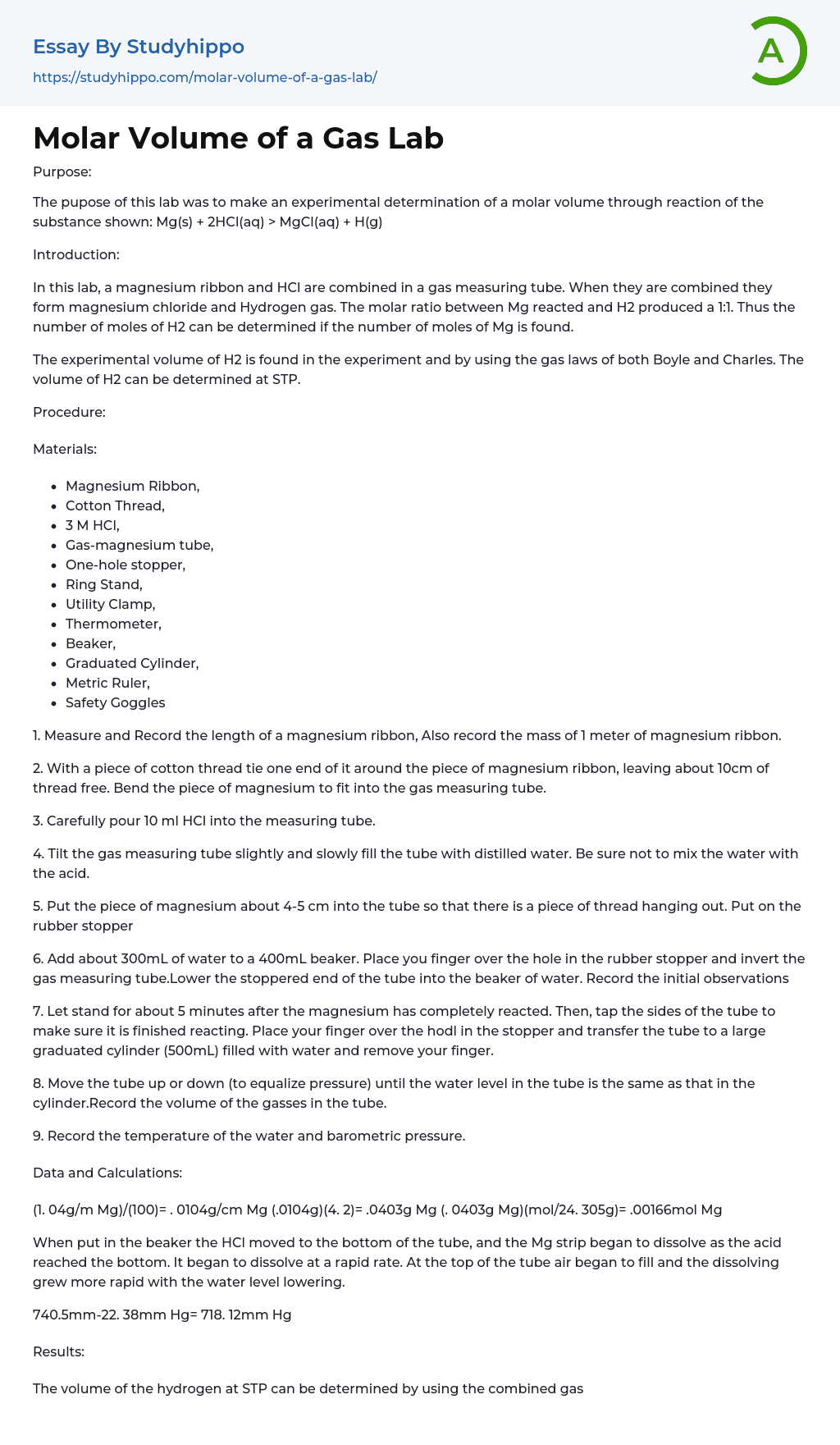Purpose:
The pupose of this lab was to make an experimental determination of a molar volume through reaction of the substance shown: Mg(s) + 2HCl(aq) > MgCl(aq) + H(g)
Introduction:
In this lab, a magnesium ribbon and HCl are combined in a gas measuring tube. When they are combined they form magnesium chloride and Hydrogen gas. The molar ratio between Mg reacted and H2 produced a 1:1. Thus the number of moles of H2 can be determined if the number of moles of Mg is found.
The experimental volume of H2 is found in the experiment and by using the gas laws of both Boyle and Charles. The volume of H2 can be determined at STP.
Procedure:
Materials:
- Magnesium Ribbon,
- Cotton Thread,
- 3 M HCl,
- Gas-magnesium tube,
- One-hole stopper,
- Ring Stand,
- Utility Clamp,
- Ther
...mometer,
- Beaker,
- Graduated Cylinder,
- Metric Ruler,
- Safety Goggles
1. Measure and Record the length of a magnesium ribbon, Also record the mass of 1 meter of magnesium ribbon.
2. With a piece of cotton thread tie one end of it around the piece of magnesium ribbon, leaving about 10cm of thread free. Bend the piece of magnesium to fit into the gas measuring tube.
3. Carefully pour 10 ml HCl into the measuring tube.
4. Tilt the gas measuring tube slightly and slowly fill the tube with distilled water. Be sure not to mix the water with the acid.
5. Put the piece of magnesium about 4-5 cm into the tube so that there is a piece of thread hanging out. Put on the rubber stopper
6. Add about 300mL of water to a 400mL beaker. Place you finger over the hole in the rubber stopper and invert the gas measuring tube.Lower the stoppere
View entire sampleJoin StudyHippo to see entire essay
end of the tube into the beaker of water. Record the initial observations
7. Let stand for about 5 minutes after the magnesium has completely reacted. Then, tap the sides of the tube to make sure it is finished reacting. Place your finger over the hodl in the stopper and transfer the tube to a large graduated cylinder (500mL) filled with water and remove your finger.
8. Move the tube up or down (to equalize pressure) until the water level in the tube is the same as that in the cylinder.Record the volume of the gasses in the tube.
9. Record the temperature of the water and barometric pressure.
Data and Calculations:
(1. 04g/m Mg)/(100)= . 0104g/cm Mg (.0104g)(4. 2)= .0403g Mg (. 0403g Mg)(mol/24. 305g)= .00166mol Mg
When put in the beaker the HCl moved to the bottom of the tube, and the Mg strip began to dissolve as the acid reached the bottom. It began to dissolve at a rapid rate. At the top of the tube air began to fill and the dissolving grew more rapid with the water level lowering.
740.5mm-22. 38mm Hg= 718. 12mm Hg
Results:
The volume of the hydrogen at STP can be determined by using the combined gas law. P1=718.12mm Hg (P1V1/T1)=(P2V2/T2) V1= . 0471 L T1=297. 15° K P2=760mm Hg V2=? T2=273. 15° K (718. 12mm Hg x . 04712)/(297.15° K)=(760mm Hg)V2/(273. 15° K) (273. 15° K/760mm Hg)((718. 12 mm Hg x . 0471 L)/297. 15° K)=((760mm Hg)V2/273.15° K) (273. 15° K/ 760mm Hg)= . 0409L V2= . 0409 L
The moles of hydrogen gas produced can be calculated using the original mass of the magnesium and the stoichiometric relationships between magnesium and hydrogen. .2 cm
Mg(1m/100cm)(1. 049g/1m)(mol/24. 305g)(1 H2/1 Mg)= . 0018 mol H2
The following is the STP volume of gas in L/mol (. 0409L H2/. 0018 mol H2)=22.7 L/mol
The volume obtained in the experiment, 22. 7 L/mol, had a . 3 difference from the accepted value of 22. 4 L/mol. The percent error can be found using the equation: [(theoretical-experimental)/(theorectical)] x 100% [(22. 4-22.7)/(22. 4)] x 100% = 1. 339%
Conclusion:
The purpose of this lab was to make an experimental determination of molar volume.The molar volume is found by using a form of the equation PV=nRT. The first set of pressure, volume, and temperature are found throughout the experiment. The second set of pressure and volume are the STP.
The molar volume obtained is 22. 7 L/mol. The accepted molar volume is actually 22. 4 L/mol. This gives the experiment a percent error of 1.339%. Experimental error could be that either excess or not enough HCl was used. This could be a reason for the . 3 difference in the molar volume obtained in the experiment and the accepted value.
- Bottled Water essays
- Experiment essays
- Explorer essays
- Hypothesis essays
- Observation essays
- Qualitative Research essays
- Research Methods essays
- Theory essays
- Amylase essays
- Distillation essays
- Magnesium essays
- John Locke essays
- 9/11 essays
- A Good Teacher essays
- A Healthy Diet essays
- A Modest Proposal essays
- A&P essays
- Academic Achievement essays
- Achievement essays
- Achieving goals essays
- Admission essays
- Advantages And Disadvantages Of Internet essays
- Alcoholic drinks essays
- Ammonia essays
- Analytical essays
- Ancient Olympic Games essays
- APA essays
- Arabian Peninsula essays
- Argument essays
- Argumentative essays
- Art essays
- Atlantic Ocean essays
- Auto-ethnography essays
- Autobiography essays
- Ballad essays
- Batman essays
- Binge Eating essays
- Black Power Movement essays
- Blogger essays
- Body Mass Index essays
- Book I Want a Wife essays
- Boycott essays
- Breastfeeding essays
- Bulimia Nervosa essays
- Business essays
- Business Process essays
- Canterbury essays
- Carbonate essays
- Catalina de Erauso essays
- Cause and Effect essays




